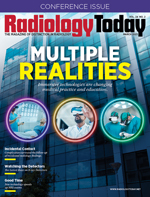 Ultrasound News: Extending Possibilities
Ultrasound News: Extending Possibilities
By Kevin Evans, PhD, RT(R) (M) (BD), (ARRT), RDMS, RVS, FSDMS, FAIUM
Radiology Today
Vol. 24 No. 2 P. 8
New advances in extended reality (XR) have enormous potential to improve the proficiency of sonographers while elevating the standards of ultrasound certification. But, more importantly, XR-based sonography can significantly expand equity and access in health care to improve patient care for all.
XR includes immersive technologies, such as augmented reality and virtual reality, merging the physical and virtual worlds to create a realistic, hands-on experience with greater interactivity and integration with radiographic data. For example, augmented reality overlays virtual information and objects in the real world, enabling hologramlike patient anatomy to be superimposed over the human body in real time. Virtual reality allows practitioners to leverage fully simulated environments, mitigating the risk involved with practicing on real-world patients.
In Training
The benefits for those seeking ultrasound training and certification using XR are many. Today, high-fidelity, manikin-based simulators are considered state of the art. But they are prohibitively expensive and inaccessible to many learners. Now that the price point of XR headsets, haptics, and other XR equipment is plummeting, we are seeing a significant spike in adoption.
XR-based simulation helps lower cost while dramatically improving access to training. It provides a safe, personalized simulation-based education that can be easily replicated, scaled, and shared across geographic boundaries. Consider, for example, a sonography student trying to juggle a job and school while caring for two children. Or a disabled student worried about wheelchair access to a training facility’s simulation lab. Or a sonographer trainee in a rural part of a developing nation. XR makes simulation-based education accessible to anyone with a headset, anywhere, at any time, with immersive, personalized training across time zones and locations.
Labs and training centers save money as well, with studies showing that XR-based simulation is 83% more cost effective than high-fidelity, manikin-based simulation. The technology’s innate scalability and flexibility can result in long-term cost savings and improved cost utility. As training application developers innovate new training content, deploying it in virtual environments is fast, simple, and less costly.
Additional Benefits
XR is improving ultrasound-guided procedures and workflow efficiency for physicians and sonographers, as well. Recent studies show up to 250% improvements in clinical and surgical performance involving ultrasound diagnostics. We’re also seeing fewer errors, higher accuracy, and improved focus when training and utilizing XR. In a virtual environment, a sonogram can be moved and viewed anywhere in a room and can even be set to follow the eyes of the sonographer. The immersive virtual environment reduces the cognitive load and creates heightened emotional connections with patients.
The technology also has a surprising ergonomic benefit that improves patient outcomes. Today, practitioners performing an interventional examination must constantly shift their attention between the patient in front of them and the display screen with the image off to the side. Their heads are constantly moving back and forth, which is distracting and diminishes the connection with the patient. XR-based simulation keeps the patient front and center at all times, improving the rapport and etiquette with the patient while physically relieving the doctor or sonographer.
XR simulation can also enable more robust, data-rich analyses by tracking inputs and interactions, as well as continuous assessment of their progression. It promotes self-driven, lifelong learning improvements in sonography by boosting practitioners’ own accountability. They can review and replay their activities in a digital environment. They can be graded or solicit feedback on their procedures. And they can practice and explore. This feedback loop helps ensure ongoing proficiency, resulting in fewer false negatives/positives in their diagnoses while reducing risk and expenses for their institutions.
Lastly, as XR simulation extends access to training, it also improves patient care. The technology promotes collaboration and consultation with other professionals, including medical specialists. So, a practitioner in rural Malawi, for example, can meet with a sonographer remotely in a virtual environment to learn how to obtain and interpret images for a specific concern, before seeing the patient. Or she can do her best to scan the patient and then meet virtually with a medical specialist in Boston in real-time to discuss the images, receive guidance, and make more informed decisions on patient care.
Hardware manufacturers and software developers are making huge strides toward incorporating XR into a sonographer’s or physician’s workflow to make scanning and procedures more accurate, easier to complete, and ergonomically safer. Expanding reach through XR will not only improve access to sonography education and improved patient care but also help drive proficiency throughout health care practitioner careers.
— Kevin Evans, PhD, RT(R) (M) (BD), (ARRT), RDMS, RVS, FSDMS, FAIUM, is the radiologic sciences and respiratory therapy director of the laboratory for investigatory imaging at Ohio State University and a former Inteleos volunteer.
